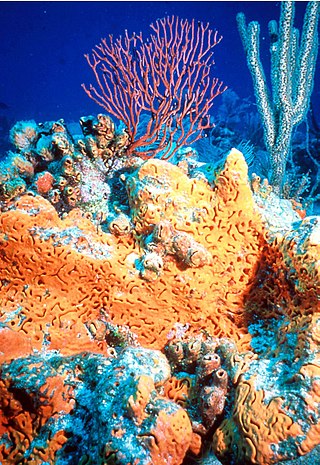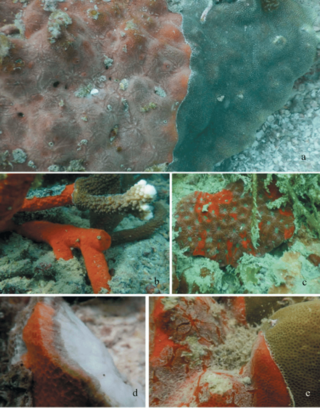
Cyclostomatida, or cyclostomata, are an ancient order of stenolaemate bryozoans which first appeared in the Lower Ordovician. It consists of 7+ suborders, 59+ families, 373+ genera, and 666+ species. The cyclostome bryozoans were dominant in the Mesozoic; since that era, they have decreased. Currently, cyclostomes seldom constitute more than 20% of the species recorded in regional bryozoan faunas.
Polymastia fusca is a species of sea sponge belonging to the family Polymastiidae. It is found in shallow subtidal habitats in the far north of North Island, New Zealand.
Proteleia tapetum is a species of sea sponge belonging to the family Polymastiidae. It is found in shallow subtidal and intertidal habitats in the far north of North Island, New Zealand.
Polymastia crocea is a species of sea sponge belonging to the family Polymastiidae. It is found in subtidal habitats below 6 m depth in the far north of the North Island of New Zealand.
Polymastia umbraculum is a species of sea sponge belonging to the family Polymastiidae. It is only known from rocky subtidal habitats around Kawau Island off the North Island of New Zealand.
Polymastia rubens is a species of sea sponge belonging to the family Polymastiidae. It is only known from rocky subtidal habitats around Kawau Island off North Island, New Zealand.
Polymastia aurantia is a species of sea sponge belonging to the family Polymastiidae. It is found in intertidal habitats including tide pools in the vicinity of Auckland, New Zealand.

Agelas clathrodes, also known as the orange elephant ear sponge, is a species of sea sponge. It lives on reefs in the Caribbean, usually more than 10 metres (33 ft) below the surface of the ocean. It takes various forms, and its color is reddish orange.

Clathrina coriacea is a species of calcareous sponge belonging to the class Calcarea and family Clathrinidae. Species in the genus Clathrina are composed of calcium carbonate tube-like skeletons containing spicules. The sponge can be located in shallow waters widely distributed along North Atlantic coasts, as well as on other coasts.
Ophlitaspongia papilla is a species of demosponge belonging to the family Microcionidae. It is found along north-eastern Atlantic coastlines. This is a red sponge which forms thin, smooth encrusting patches, up to 5 cm across, with regularly spaced oscula.
Agelas schmidti, commonly known as the brown tubular sponge, is a species of demosponge. It occurs at moderate depths in the Gulf of Mexico and the Caribbean Sea and often has a colonial coral growing over the surface. The type locality is Puerto Rico.
Iotrochota birotulata, commonly known as the green finger sponge, is a species of sea sponge in the family Iotrochotidae. It is found in shallow waters in the Caribbean Sea.
Lobophora variegata is a species of small thalloid brown alga which grows intertidally or in shallow water in tropical and warm temperate seas. It has three basic forms, being sometimes ruffled, sometimes reclining and sometimes encrusting, and each form is typically found in a different habitat. This seaweed occurs worldwide. It is the type species of the genus Lobophora, the type locality being the Antilles in the West Indies.

Clathria prolifera, commonly known as red beard sponge, is a species of sea sponge in the family Microcionidae. It is native to shallow water habitats in the western Atlantic Ocean from Prince Edward Island southwards to Florida and Mexico, and possibly Brazil. In the twentieth century it also became established on the west coast of the United States.
Corticium candelabrum is a species of sponge in the order Homosclerophorida. It is native to the eastern Atlantic Ocean and the Mediterranean Sea where it inhabits the shallow sublittoral zone. The type locality is the Adriatic Sea.

Aplysina aerophoba is a species of sponge in the family Aplysinidae. It is a yellow, tube-forming or encrusting sponge and is native to the eastern Atlantic Ocean and the Mediterranean Sea; the type locality is the Adriatic Sea.

Clathria aceratoobtusa is a species of sponge in the family Microcionidae. The genus Clathria is subdivided into a number of subgenera, and it is in the subgenus Microciona. It is native to shallow water habitats in the Indo-Pacific region. The type locality is the Gulf of Thailand.

Coelosphaeridae is a family of sponges belonging to the order Poecilosclerida. Species are found across the globe.
Calcifibrospongiidae is a family of sponges belonging to the order Haplosclerida. The order Haplosclerida is distinguished by isodictyal skeleton. In general, Porifera are basal animals with bodies full of pores and channels. Calcifibrospongiidae includes the species Calcifibrospongia actinostromarioides. There have only been ten recorded occurrences of this species: in Hogsty Reef and San Salvador, as well as in the subtropics of the Bahamas.
Oscarella tuberculata is a species of sponge in the order Homosclerophorida. It is endemic to the Mediterranean Sea, where it forms encrusting colonies on rocks and other hard surfaces.







